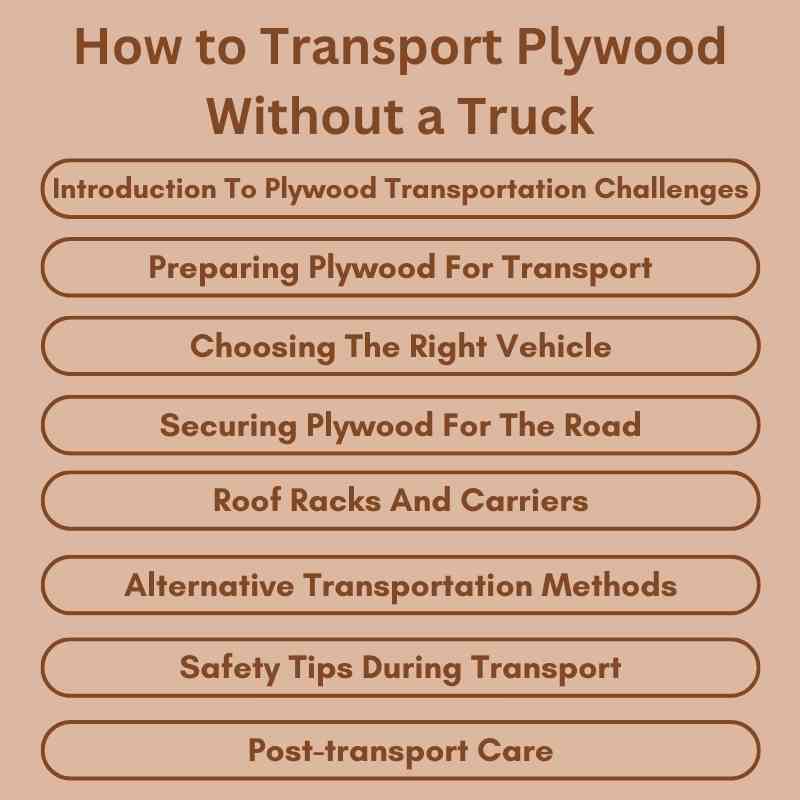To transport plywood without a truck, use a roof rack or a trailer. Secure the plywood with straps for safety during transit.
Transporting plywood can be challenging, especially without a truck. Many DIY enthusiasts and builders often find themselves in this situation. Plywood sheets are bulky and can be difficult to maneuver. However, various alternatives exist for safely transporting plywood. Options like using a sedan with a roof rack or even a utility trailer can work effectively.
Knowing the right techniques and safety measures can make the task easier. This guide will explore practical methods to help you transport plywood securely and efficiently. Whether you’re heading to a job site or a DIY project, these tips will ensure a smooth experience.
Introduction To Plywood Transportation Challenges
Transporting plywood can be tricky. Large sheets are difficult to handle without a truck. Common issues include damage during transport and difficulty fitting sheets in smaller vehicles.
Another concern is safety. Make sure sheets are secured properly. Loose sheets can slide and cause accidents. Legal concerns also arise. Some areas have laws about transporting large items.
Using a roof rack or trailer can help. Ensure they are strong enough for the weight. Always check local traffic laws before transporting plywood.

Preparing Plywood For Transport
Cutting plywood into manageable sizes makes transport easier. Use a saw for clean edges. Aim for pieces that fit in your vehicle. This reduces the risk of damage.
Wrap each piece of plywood with protective materials. Use moving blankets or bubble wrap. Secure them with tape to keep them in place. This protects against scratches and dents.
Consider using cardboard sheets between the plywood layers. This adds extra protection during transport. Straps or rope can help keep everything secure in your vehicle.
Choosing The Right Vehicle
Transporting plywood can be tricky without a truck. Sedans and hatchbacks are options for small pieces. Fold down the back seats to create extra space. Use a roof rack or cargo carrier for longer sheets. Make sure to secure the plywood to prevent sliding.
SUVs and vans offer more room for larger plywood. These vehicles usually have a flat floor. Always check the dimensions to ensure a good fit. Use straps or bungee cords to hold the plywood in place. This keeps it safe during transport.
Securing Plywood For The Road
Securing plywood for transport requires proper techniques. Ropes and straps are essential tools. Always use strong materials that can hold weight. Wrap the plywood tightly to avoid movement. Make sure to secure all edges. This prevents sliding during transit.
To avoid common mistakes, check the knots carefully. Loose knots can lead to accidents. Always double-check the strap tension. Too tight can damage the plywood, while too loose can cause it to shift. Keep the plywood flat to maintain stability. Use padding if needed to protect edges.
Roof Racks And Carriers
To transport plywood without a truck, using a roof rack system is effective. Installing a roof rack requires careful attention. First, check your car’s compatibility with the rack. Read the instructions thoroughly for proper setup. Ensure the rack is securely attached to avoid accidents.
Here are the pros and cons of carriers:
| Pros | Cons |
|---|---|
| Easy to install | Can be expensive |
| Increases storage space | May affect fuel efficiency |
| Versatile for different items | Requires regular maintenance |
Using a roof rack or carrier allows flexibility. Choose the right option based on needs.
Alternative Transportation Methods
Transporting plywood without a truck is possible. Trailers are a great option. They can attach to many vehicles. Ensure the trailer is properly secured for safety. Use straps to keep the plywood in place.
Delivery services can also help. Many companies offer transportation for large items. Check local services for availability. They often have the right tools to handle plywood.
| Method | Benefits |
|---|---|
| Trailer | Easy to use with many vehicles |
| Delivery Services | Professional handling of large items |
Safety Tips During Transport
Always check for road hazards before transporting plywood. Look for potholes, debris, and sharp turns. These can damage your load or cause accidents.
Be aware of overhead obstacles like bridges and power lines. They can pose a threat to oversized loads. Use a spotter to guide you if needed.
When navigating with oversized loads, drive slowly and carefully. Avoid sudden movements to keep the plywood steady. Use flashers to alert other drivers.
Choose routes with fewer obstacles. Avoid busy roads and tight spaces when possible. Planning helps in safer transport.
Post-transport Care
Unloading plywood requires care to avoid damage. Always use two people to lift large sheets. Keep the plywood flat during unloading. Avoid dragging it across surfaces to prevent scratches.
After unloading, store plywood in a dry area. Elevate it from the ground using blocks or pallets. Covering with a tarp protects it from moisture. Ensure the sheets are stacked flat to avoid warping.
DIY Solutions And Hacks
Transporting plywood without a truck can be easy with some creativity. A makeshift carrier can help carry large sheets. Use strong ropes or straps to secure the plywood. A sturdy bicycle can also serve as a great option. Simply attach the plywood to the bike’s frame.
Many household items can make this task easier. For instance, use an old door as a base. Place the plywood on top and secure it. A trolley or cart can also work well. Just ensure the wheels are sturdy and can handle weight.
| Item | Use |
|---|---|
| Bicycle | Attach plywood to the frame |
| Old Door | Serve as a base for support |
| Trolley | Transport plywood easily |
Legal And Insurance Considerations
Understanding local laws is essential for transporting plywood. Many places have specific rules. Check your area’s regulations on vehicle size and load limits. Some regions require permits for oversized loads.
Insurance coverage is crucial for protecting your cargo. Verify that your policy includes transportation coverage. If transporting for a business, ask about commercial insurance options. Always keep documentation of your insurance handy.

Frequently Asked Questions
How Can I Transport Plywood Without A Truck?
You can transport plywood using a car with a large trunk or back seat. Secure the sheets with straps to prevent sliding. Alternatively, consider using a roof rack or trailer hitch, if available. Always ensure that the plywood is properly balanced and visible for safety while driving.
What Are Alternatives To A Truck For Hauling Plywood?
Alternatives include using a van, SUV, or station wagon. You can also rent a small moving truck or van for a short period. Additionally, consider asking a friend with a larger vehicle to assist. Local delivery services may offer affordable options for transporting plywood.
Can I Use Public Transport For Plywood Delivery?
Yes, some public transport options can accommodate plywood. Check with your local transit authority for specific guidelines. Ensure the plywood fits within size restrictions and is safely secured. Be prepared for potential inconveniences, like limited space and needing assistance.
What Tools Help Transport Plywood Easily?
Tools like ratchet straps, moving blankets, and dollies can be very helpful. Ratchet straps secure the plywood, preventing movement during transport. Moving blankets protect the surfaces, while dollies make lifting easier. Always have a friend to help lift heavier sheets for safety.
Conclusion
Transporting plywood without a truck is entirely feasible with the right techniques. From using a roof rack to employing a sturdy trailer, there are various methods to consider. Always prioritize safety and secure your load properly. With these tips, you can efficiently transport plywood and tackle your projects with ease.

